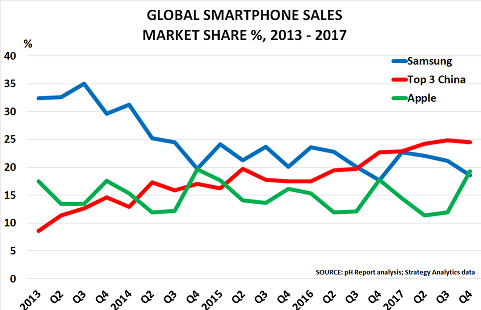
Global smartphone sales have seen major growth until recently as consumers fell in love with going mobile, as the chart shows:
“It was the biggest annual fall in smartphone history (and) …. was caused by a collapse in the huge China market, where demand fell 16% annually due to longer replacement rates, fewer operator subsidies and a general lack of wow models.”
Even more revealing was that only Xiaomi of the Top 5 vendors increased their volume. Apple lost 1m sales, Samsung lost 3m, Huawei lost 4m, whilst even OPPO only managed to maintain its volume. And Xiaomi only did well because they were recovering from their 2016 collapse when their share crashed to just 3.35% from 5% in Q4 2015.

Chinese companies were, however, the real winners during 2017 as the price war intensified, as the second chart confirms:

The rise of the Chinese vendors is great news for consumers, but very bad news for their competitors, as the third chart confirms. It highlights how revenues are now being squeezed for most vendors as the Chinese ramp up their volume. Only Apple has avoided the carnage by heading defiantly up-market, with its average handset price now close to $800.
The issue is the very different nature of the smartphone market in the major emerging economies, where incomes are much lower than in the West and it is very rare for carriers to subsidize handset sales over the life of the contract. In India, for example, the typical smartphone sells for less than $200, whilst Apple has less than 2% of the market.
















Leave A Comment